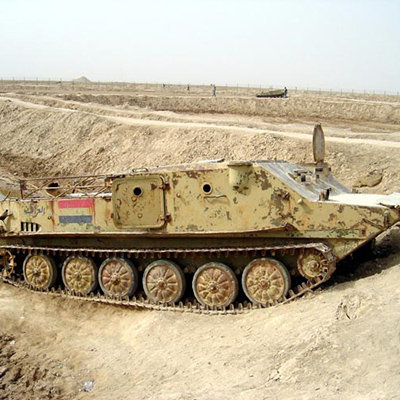Warfare
Khashayar
Mohsen Shir-Muhammad
82 Views
Khashayar, also known as the BTR-50, is an armored personnel carrier that played a significant role during the Iran-Iraq War, particularly in amphibious operations, facilitating the transport of Iranian forces. This Soviet-made armored amphibious personnel carrier, was developed based on the PT-76 light tank chassis. Unlike other wheeled BTR series vehicles, the BTR-50 is a tracked carrier.[1] It measures 7.7 meters in length, 3.14 meters in width, and 2.03 meters in height.[2] It weighs approximately 14.5 tons and is powered by a 240-horsepower diesel engine located at the rear. The troop compartment in the middle can carry up to 20 soldiers. Its steel armor, ranging in thickness from 7 mm at the rear to 13 mm at the front, provides protection against 7.62 mm bullets and small shrapnel. The BTR-50’s flat, boat-like hull allows it to float effectively on water, with water jets on both sides enabling maneuverability.[3] The vehicle’s low freeboard of 15 to 20 cm and lack of a snorkel help it remain buoyant in rough waters.[4]
The BTR-50 is equipped with a reductor system for water propulsion, featuring two propellers. Each propeller draws water from the riverbed and expels it through rear vents, propelling the vehicle at a maximum speed of 10.2 km/h on water.[5] On land, with five forward gears and one reverse gear, it can reach a speed of up to 45 km/h.[6]
The BTR-50 was used by Egypt and Syria against Israel in the Six-Day War (1967), with some captured by Israeli forces. Egypt, Syria, and Israel further deployed the vehicle during the Yom Kippur War (1973).[7] Before the Islamic Revolution, the Iranian Army purchased 1000 BTR-50 carriers from the Soviet Union in exchange for gas exports, renaming them Khashayar.[8] However, after being used in a military exercise in Khuzestan, Army commanders deemed them ineffective which led to their decommissioning.[9]
Starting in 1982, during the Iran-Iraq War, the Islamic Revolutionary Guard Corps (IRGC) prioritized refurbishing Khashayar as it needed armored vehicles. Subsequently, three units were rebuilt with Western engines for testing.[10] In Operation Kheibar (February-March 1984), Khashayar carriers proved invaluable for assembling floating Kheibar bridges, demonstrating their strategic advantage in marshy areas.[11] In the Faw region, Khashayar carriers performed effectively in water, land, and swamp environments.[12] During Operation Val Fajr 8, after successfully crossing the Arvandrud River, Khashayar units played a vital role for 20 consecutive days, transporting troops, ammunition, supplies, and wounded personnel, as well as transferring the bodies of martyrs to the Arvandrud shore and supporting infantry units in Faw’s front lines.[13]
By 1985, the IRGC Ministry purchased 1000 Maybach engines for approximately $10 million, initiating the overhaul of 1000 Khashayar carriers in heavy industry factories across Iran,[14] with one vehicle refurbished every three days.[15] A total of 744 Khashayar carriers were introduced into the IRGC armored organization between 1983 and 1985.[16]
One of the main concerns of the IRGC commanders during the Iran-Iraq War, especially after Operation Ramazan, was the use of armored vehicles to transport troops to the enemy’s second and third defensive lines after breaching the first one. If IRGC units had armored personnel carriers, they could effectively move forces closer to subsequent enemy lines, preventing troop exhaustion from long marches. Consequently, the IRGC leadership focused on utilizing Khashayar carriers. From December 26, 1986, tasks such as transferring Khashayar vehicles from Tehran to the war zone, mounting DShK machine guns on them, and repairing and refurbishing these carriers were prioritized. In the meantime, efforts began to conduct maneuvers with Khashayar carriers in the Salman Canal (southern Khuzestan). Their operational roles included troop transport and assisting in line clearance using the DShK machine gun.[17] For Operation Karbala 5, 150 Khashayar vehicles were prepared.[18]
In Operation Karbala 5, the strategy emphasized crossing the Fish Canal and advancing from north to south behind enemy fortifications. Therefore, Khashayar and other personnel carriers were used for troop transport across the canal (north of Basra) and for clearing enemy lines.[19] In addition to the IRGC Khashayar vehicles, 136 personnel carriers were provided by the Islamic Republic of Iran Army for this operation.[20]
During Operation Karbala 5, forces under the Karbala Headquarters were tasked with capturing bridges over the Fish Canal, the Pentagon area, and Pad Bubiyan and its embankments. This required crossing the flooded areas near the Zaid outpost in which the water was as deep as 20 cm to 2 meters. Therefore, they needed a vehicle unaffected by varying depths. Finally, due to the uneven underwater terrain, Khashayar carriers were employed. These carriers could swiftly transport troops to dry land, enabling engagement with the enemy. Using Khashayar vehicles, the forces crossed the flooded areas and created routes, allowing other units to support troops within the first 24 hours until the rear lines were secured.[21]
After the war, Khashayar carriers were also used for public welfare. For instance, during the 2019 Khuzestan floods, many people trapped in flooded villages were rescued by Khashayar armored carriers operated by the Hazrat Hojjat (as) Armored Brigade of the IRGC Ground Force.[22]
[1] Sait-e Enama, Oboor kardan BTR-50 az Khandaq va Mavane (Crossinge the Ditches and Obstacles by BTR-50), 1400, HTTPS://ENAMA.IR/VIDEOS/1162436.
[2] Jafari, Fathollah, Chenaneh-Khodnegasht Fathollah Jafari (Chenaneh- Autobiography by Fathollah Jafari), Tehran, Markaz Asnad va Tahqiqat Defa-e Muqaddas, 1402, p. 444.
[3] Ibid.
[4] Sait-e Military, Nafarbar Khashayar (Khashayar Carrier), 29 Tir 1393, WWW.MILITARY.IR/FORUMS/TOPIC/2811.
[5] Bolouri, Muhammad, Taxi Servisi baraye Faw (Taxi for Faw), Tehran, Sureh Mehr, 1398, p. 402.
[6] Ibid., p. 428.
[7] Sait-e Military, Ibid.
[8] Jafari, Fathollah, Ibid., p. 444.
[9] Sait-e Fardanews, Majeraye Bazsazi-e 1000 Nafarbar BTR-50 dar Iran (The Story of Refurbishing 1000 BTR-50 Carriers), 1 Aban 1398, www.fardanews.com.
[10] Jafari, Fathollah, Ibid, p. 444.
[11] Sait-e Fardanews, Ibid.
[12] Ibid.
[13] Bolouri, Muhammad, Ibid., p. 476.
[14] Alaee, Hussain, Barrasi Naghsh-e Dowlat Jomhouri Eslami Iran dar Jang Tahmili Araq alayhe Iran (Examining the Role of the Islamic Republic of Iran in Iraq’s Imposed War against Iran), Faslnameh Motaleat Beynolmelali, No. 64, Bahar 1399, p. 145.
[15] Sait-e Military, Ibid.
[16] Jafari, Fathollah, Ibid., p. 444.
[17] Amaliyat Karbala 5, Oboor az Bohran Nakami dar Amaliyat Sarneveshtsaz (Operation Karbala 5, Overcoming the Crisis of Failure in the Decisive Operation), Sazman Asnad va Madarek Defa-e Muqaddas, www.defadocs.ir.
[18] Allamian, Saeed, Baraye Tarikh Migooyam-Khaterat Mohsen Rafiqdoost 1368-1357 (I Speak for History-Memoirs of Mohsen Rafiqdoost 1978-1989), Tehran, Sureh Mehr, 1392, Pp. 358 and 360.
[19] Doroodian, Muhammad, Seyri dar Jang Iran va Araq-Faw ta Shalamcheh (A Journey Through the Iran-Iraq War-Faw to Shalamcheh), Vol. 3, Tehran, Markaz Motaleat va Tahqiqat Jang, 1378, p. 131.
[20] Amaliyat Karbala 5, Oboor az Bohran Nakami dar Amaliyat Sarneveshtsaz (Operation Karbala 5, Overcoming the Crisis of Failure in the Decisive Operation), Ibid.
[21] Khabargozari ISNA (ISNA Press), kod-e khabar: 97102211526, 22 Dey 1397.
[22] Sait-e Bashgah Khabarnegaran Javan (Bashgah Khabarnegaran Javan Website), kod-e khabar: 6895603, 23 Farvardin 1398.





